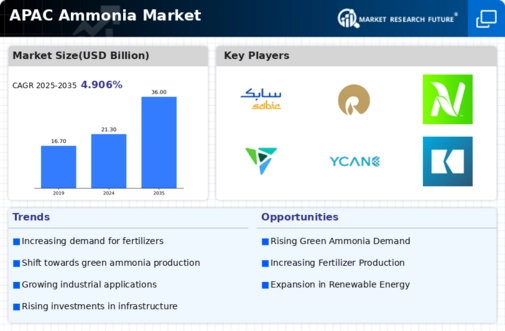The competitive insights of the APAC Ammonia Market reveal a dynamic landscape shaped by regional demand, production capacities, and strategic initiatives by key players. As ammonia is a key ingredient in fertilizers and various industrial applications, the competition is influenced by factors such as cost of production, technological advancements, and supply chain efficiencies. The market has experienced fluctuations due to varying agricultural practices, government policies, and environmental regulations across countries in the Asia-Pacific region.
Understanding these competitive dynamics is crucial for stakeholders aiming to navigate the complexities of market demands and leverage opportunities for growth within this sector.SABIC holds a strong position within the APAC Ammonia Market, leveraging its extensive production capabilities and innovation in chemical processes. The company's manufacturing facilities are strategically located in key markets, enabling it to efficiently serve local and regional demands. SABIC's robust network and supply chain optimization further fortify its market presence, catering to the growing requirements of ammonia as a fundamental input for fertilizers.
The company is recognized for its commitment to sustainability, focusing on minimizing the environmental impact of its operations while delivering high-quality products. Additionally, SABIC's significant investment in RD fosters the development of advanced ammonia production methods, allowing the company to remain competitive in a rapidly evolving market.Indian Farmers Fertiliser Cooperative (IFFCO) plays a pivotal role in the APAC Ammonia Market, focusing on supporting farmers with essential nutrients and fertilizers. The company’s key products include urea and other nitrogenous fertilizers derived from ammonia, which are critical for enhancing agricultural yields in the region.
IFFCO's strong presence in India enables it to capitalize on the large agricultural sector that relies heavily on ammonia-based fertilizers. The company’s strengths lie in its extensive distribution network and partnerships with local cooperatives, enhancing its outreach and service delivery. IFFCO has also been involved in strategic collaborations and potential mergers that aim to augment its production capacity and efficiency. By embracing innovative technologies and production processes, IFFCO continues to solidify its position in the competitive landscape of the APAC ammonia market, catering to the growing needs of farmers while driving agriculture resilience in the region.




















Leave a Comment